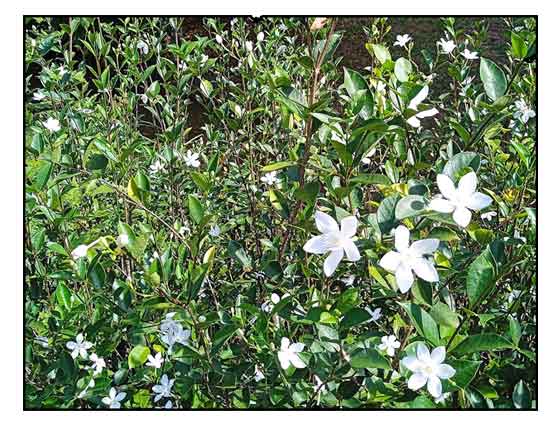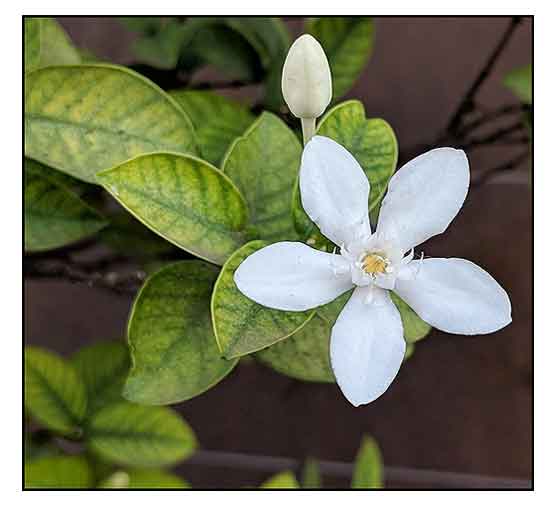 Gen info Gen info
- Wrightia antidysenterica is a flowering plant in the genus Wrightia.
- It is sometimes confused with species Holarrhena pubescens due to an invalid taxonomical publication of the name Holarrhea pubescens. (2)
- Etymlogy: The genus Wrightia is named after Dr William Wright (1740-1827), a Scottish physician and botanist. The species epithet antidysenterica means "against dysentery", referring to its medicinal property. (4)
Botany
• Bushy shrub, able to grow up to about 1.5 m tall. Foliage: Green leaves, ovate to elliptic in shape, opposite arrangement, measuring about 2.5 - 6 cm long and 1.5 - 2.5 cm wide. Flowers: White fragrant 5-petaled flowers with a yellow centre, measuring about 2.5 cm wide, corolla tube very slender and about 2 - 2.5 cm long. Fruit: Fruit is a pod-liked follicle. (4)
 • Stem: Younger branches glabrous, green and divaricate, whereas the mature stem brown. Presence of light yellow milky latex observed while plucking leaves and flowers. Leaves: Leaf arrangement opposite decussate. Leaves are simple, glabrous, entire margin, ovate, obtuse base and cuspidate apex. Blade green in adaxial surface and light green in abaxial surface with 3–5.5 cm long and 2–3.1 cm wide. Petiole short, light green, glabrous, 0.3–0.5 cm length and 0.1–0.2 cm width. Pinnate venation and have 8–11 secondary veins. Inflorescence: Inflorescence terminal cyme. Peduncle brown, glabrous, 2–2.7 cm long and 0.2 cm wide. Bract small, light green, glabrous, acute apex, 0.1 cm length and 0.1 cm width. Flower: Flowers star-shaped, single whorl, five petaled, white with androecium at the center which is yellow in color with 3.4–4 cm length and 1.9–2.8 cm breadth (Plate 5). Pedicel light green, glabrous, 0.4–0.8 cm length and 0.1–0.2 cm width. Flower bud was ovate shaped, white, 3–3.4 cm length and 0.6–0.7 cm width. (5) • Stem: Younger branches glabrous, green and divaricate, whereas the mature stem brown. Presence of light yellow milky latex observed while plucking leaves and flowers. Leaves: Leaf arrangement opposite decussate. Leaves are simple, glabrous, entire margin, ovate, obtuse base and cuspidate apex. Blade green in adaxial surface and light green in abaxial surface with 3–5.5 cm long and 2–3.1 cm wide. Petiole short, light green, glabrous, 0.3–0.5 cm length and 0.1–0.2 cm width. Pinnate venation and have 8–11 secondary veins. Inflorescence: Inflorescence terminal cyme. Peduncle brown, glabrous, 2–2.7 cm long and 0.2 cm wide. Bract small, light green, glabrous, acute apex, 0.1 cm length and 0.1 cm width. Flower: Flowers star-shaped, single whorl, five petaled, white with androecium at the center which is yellow in color with 3.4–4 cm length and 1.9–2.8 cm breadth (Plate 5). Pedicel light green, glabrous, 0.4–0.8 cm length and 0.1–0.2 cm width. Flower bud was ovate shaped, white, 3–3.4 cm length and 0.6–0.7 cm width. (5)
Distribution
- Cultivated, not naturalized. (3)
- Ornamental cultivation for its perennial production of white flowers.
-
Native to Sri Lanka.
(1)
- In Sri Lanka, listed as vulnerable.
Constituents
- Study isolated a new aminobenzoyl glycoside, 2-aminobenzoyl O-ß-D-apiofuranosyl-(1-->6)-ß-D-glucopyranoside (1) and two new megastimane glycosides, wrightiainosides A (10) and B (11), along with 17 known compounds, including four benzoxazinoid glycosides (2-5), one indole diglycoside (6), three simple aromatic glycosides (7-9), three megastimane glycosides (12-14), five flavonoid glycosides (15-19), and one lignan (20). (8)
- Qualitative phytochemical screening
of W. antidysenterica leaves yielded alkaloids, anthraquinones, coumarins, flavonoids, phenols, steroids/sterols, sugars, tannins, triterpenes. (see study below) (9)
Properties
-
Studies have suggested emetic, antimicrobial, antioxidant, tyrosinase inhibitory, anti-browning, antilipidemic properties.
Parts used
Bark, seeds, leaves.
Uses
Edibility
- No report found on edibility.
Folkloric
- No reported folkloric medicinal use in the Philippines.
- Bark used for treatment of dysentery.
- Dried or powdered bark rubber over the body for treatment of dropsy.
- Seeds used for treatment of fevers, intestinal worms, diarrhea and dysentery.
- Juice from bark applied to mouth sores. Leaves used for skin disorders, such as dermatitis and psoriasis. (4)
- Decoction of flowers and roots taken for treatment of snake bites (Russell's viper). Infusion of leaves used for tonsilitis and bronchial diseases. (10)
Others
- Composite material: The juice of the plant is a potent ingredient in a mixture of wall plaster, according to the Samarangana Sutradhara, a Sanskrit treatise dealing with Silpasastra (Hindu science of art and construction.) (2)
Studies
• Therapeutic Emetic Agent in Treatment of Psoriasis: Wrightia antidysenterica (WD) is a male variety Kutaja, considered a potent therapeutic emetic agent in skin disorders. Expulsion of doshas through the oral route is termed as Vamana Karma (VK) or therapeutic emesis. Study evaluated the efficacy of W. dysenterica as a therapeutic emetic agent (vamaka yoga) in the management of psoriasis. VK with WA showed significant relief in parameters of psoriasis such as scaling, itching, candle grease sign (p<0.001) and psoriasis area and severity score (P=0.001). Results suggested a potent therapeutic emetic agent with clinical benefits on skin disorders like psoriasis. (6)
• Antimicrobial / Leaves: Study evaluated the antimicrobial activity of leaf fractions of W. dysenterica against Gm- and Gm+ bacteria and fungal species using Kirby-Bauer disk diffusion method. The DCM (dichloromethane) crude extract inhibited growth of most representative species. DCM fraction 4 (WAD-4) showed greatest antimicrobial activity specifically against Streptococcus pneumonia and Bacillus subtilis. Results showed subfractions WAD-4.4 and WAD-4.5 exhibited inhibitory, bactericidal, and fungicidal activities ranging from 10 mg/mL to 2.5 mg/mL. WAD subfractions yielded flavonoids, phenol, triterpenes, and sterols. (7)
• Antioxidant / Leaves: Antioxidant activity by DPPH free radical scavenging assay showed IC50 value of 107 µg/mL) compared to ascorbic acid (38 µg/mL). (see constituents above) (9)
• Tyrosinase Inhibitory / Anti-Browning Effect: Inhibition of tyrosinase is one of the most significant measurements in regulations of enzymatic browning and melanogenesis. Wrightia antidysenterica exhibited potent tyrosinase inhibitory activity with IC50 of 4.5 µg/mL. Fourteen natural tyrosinase inhibitors were isolated including three alkaloids, two quercetin glycosides, four apigenin glycosides, and five kaempferol glycosides. The most potent tyrosinase inhibitor 4-hydroxyphenyl nitrite (4-HPN) showed IC50 of 18.6 µM, which was 5X stronger than positive control, kojic acid. Inhibition was via a competitive mechanism with inhibitory constant Ki of 8.27 µM. Evaluation of anti-browning effect of crude extract on apple slices indicated the crude extract of WA can significantly slow down enzymatic browning to maintain attractive appearance of fresh fruits. (11)
• Antioxidant / Antilipidemic: Finely powdered leaves, stems, roots, flowers, and whole plant were subjected to sequential extraction with hexane, dichloromethane and methanol and evaluated for functional activity. Methanol stem extract exhibited highest antioxidant activity with mean IC50 of 0.47 mg/ml, compared to positive control butylated hydroxytoluene at 0.11 mg/ml. In antilipidemic assay, hexane, DCM, and methanol extracts of whole plant, DCM flower extract, and methanol stem extract showed inhibition similar to Orlistat (an antiobesity drug) (43%) at 1 mg/ml concentrations at 39%, 39%, 39%, 40% and 38% respectively. No anti-amylase activity was seen. Results suggest antioxidant and antilipidemic activity. (12)
Availability
- Cultivated.
-
Seeds in the cybermarket.
|

![]()





